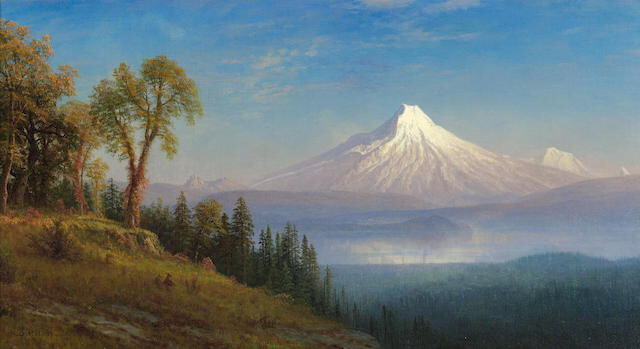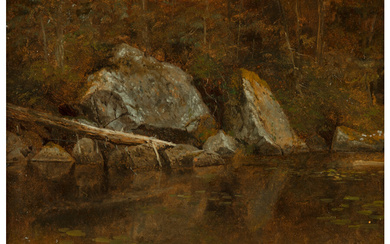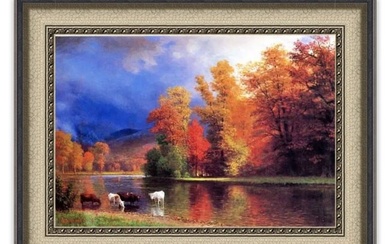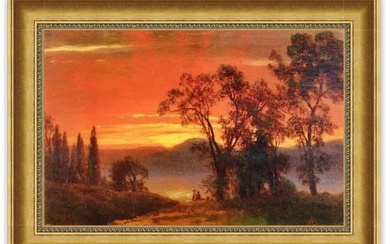Albert Bierstadt, (1830-1902)
Mount St. Helens, Columbia River, Oregon 18 x 32 1/2in
Mount St. Helens, Columbia River, Oregon
signed with conjoined initials 'ABierstadt' (lower left)
oil on canvas
18 x 32 1/2in
Painted circa 1889.
Provenance
Sale, Sotheby Parke Bernet, New York, April 25, 1980, lot 170A.
(probably) Acquired by the late owner from the above.
Literature
S.H. McGarry, Honoring The Western Tradition: The L.D. "Brink" Brinkman Collection, Kerrville, Texas, 2003, p. 4, illustrated.
We wish to thank Melissa Webster Speidel, President of the Bierstadt Foundation and Director of the Albert Bierstadt catalogue raisonné project, for her kind assistance in cataloguing this lot. This painting will be included in her forthcoming catalogue raisonné on the artist's work and she has prepared the following essay:
Mount St. Helens, Columbia River, Oregon1 depicts one of the distinctive volcanoes in the Cascades, a western mountain range that extends from British Columbia, Canada, through the states of Washington and Oregon to Northern California. Albert Bierstadt visited the Columbia River and the Northwest at least twice during his career. The first time was in 1863 with fellow traveler Fitz Hugh Ludlow when they headed to Oregon from California and then, via the Columbia River, they ascended to the mouth of the Snake River. His second trip came in the fall of 1889. After visiting Alaska in the summer, he traveled to Oregon and Washington to make sketches of the great looming volcanoes seen from the Columbia River. Mount St. Helens, Columbia River, Oregon most likely dates from this second trip.
1889 was an eventful year for Bierstadt. By this time, he was a highly successful, well-established artist with a national and international reputation. As one newspaper article stated on March 3, 1889, "Albert Bierstadt is a fixture in New York, moves along the upper crust of society and no longer has to work for a living with the brush."2 Another article this same year said that the artist was "one of America's greatest painters," and that he was "a tireless worker and had made a fortune."3
Bierstadt was an indefatigable traveler. He set sail for Europe in March 1889, to oversee the hanging of The Last of the Buffalo at the Paris Salon. An art committee of his peers rejected this monumental painting for exhibition at the Paris Exposition Universelle, but Bierstadt was not about to let their rejection deter him from making sure his painting was seen. On view in Paris at the Salon, the painting, now considered to be one of the artist's finest works, hung there during the Exposition so that anyone visiting Paris for the exhibition could still see his painting.
By July, Bierstadt was back home and preparing for three months of travel in the West to make studies for paintings. In late July, Bierstadt left for Canada by railroad traveling to Banff, Alberta, and then by steamer in August to Loring Bay, Alaska. From there he traveled back to Canada, to Vancouver, and then, perhaps encouraged by the sale of one of his Mount Hood paintings earlier that year, traveled south to Washington Territory and Oregon in September and October to sketch Mount Rainier, Mount Hood and Mount St. Helens.
Mount St. Helens, Columbia River, Oregon is a superb example of Bierstadt's skill as a landscapist. The viewer approaches the painting from the left where the top of a sloping hill offers firm footing. The colors of fall are seen in the foliage of the deciduous trees as two deer nestle in the deep grass. From there, the vista falls off into the valley below, where the Columbia River snakes its way through an intervening atmospheric haze. In the distance, bright and clear, the top of Mount St. Helens is covered in fresh snow.
Bierstadt was enamored of the Northwest's snowy, iconic peaks, painting at least two dozen views of the volcanoes that dot the region. In Mount St. Helens, Columbia River, Oregon, Bierstadt's vantage point is from Mt. Mitchell, a smaller peak near Mount St. Helens. To the right is Mount Rainer and to the far right is Glacier Peak.4 A steel engraving by Clohessy and Strengele from 1890 shows a similar depiction of Mount St. Helens. Theirs includes the city of Portland in the foreground. Still an active volcano, Mount St. Helens erupted in 1980. Much of the northern face of the mountain collapsed creating a huge crater, changing forever the mountain's profile as preserved in Bierstadt's 1889 majestic scene.
1 That Bierstadt may have titled the painting Oregon is not unusual. It was common for easterners to view the Pacific Northwest as Oregon, and Washington did not become a state until November, 1889, after Bierstadt had returned home to New York from his 1889 trip.
2 San Francisco Chronicle, March 3, 1889, p. 14.
3 St. Johnsbury Republican, St. Johnsbury, VT, August 1, 1889, p. 4.
4 Cheryl Mack, retired archaeologist for the Gifford Pinchot National Forest, identified the vantage point and confirmed the peaks depicted.
View it on
Estimate
Time, Location
Auction House
Mount St. Helens, Columbia River, Oregon 18 x 32 1/2in
Mount St. Helens, Columbia River, Oregon
signed with conjoined initials 'ABierstadt' (lower left)
oil on canvas
18 x 32 1/2in
Painted circa 1889.
Provenance
Sale, Sotheby Parke Bernet, New York, April 25, 1980, lot 170A.
(probably) Acquired by the late owner from the above.
Literature
S.H. McGarry, Honoring The Western Tradition: The L.D. "Brink" Brinkman Collection, Kerrville, Texas, 2003, p. 4, illustrated.
We wish to thank Melissa Webster Speidel, President of the Bierstadt Foundation and Director of the Albert Bierstadt catalogue raisonné project, for her kind assistance in cataloguing this lot. This painting will be included in her forthcoming catalogue raisonné on the artist's work and she has prepared the following essay:
Mount St. Helens, Columbia River, Oregon1 depicts one of the distinctive volcanoes in the Cascades, a western mountain range that extends from British Columbia, Canada, through the states of Washington and Oregon to Northern California. Albert Bierstadt visited the Columbia River and the Northwest at least twice during his career. The first time was in 1863 with fellow traveler Fitz Hugh Ludlow when they headed to Oregon from California and then, via the Columbia River, they ascended to the mouth of the Snake River. His second trip came in the fall of 1889. After visiting Alaska in the summer, he traveled to Oregon and Washington to make sketches of the great looming volcanoes seen from the Columbia River. Mount St. Helens, Columbia River, Oregon most likely dates from this second trip.
1889 was an eventful year for Bierstadt. By this time, he was a highly successful, well-established artist with a national and international reputation. As one newspaper article stated on March 3, 1889, "Albert Bierstadt is a fixture in New York, moves along the upper crust of society and no longer has to work for a living with the brush."2 Another article this same year said that the artist was "one of America's greatest painters," and that he was "a tireless worker and had made a fortune."3
Bierstadt was an indefatigable traveler. He set sail for Europe in March 1889, to oversee the hanging of The Last of the Buffalo at the Paris Salon. An art committee of his peers rejected this monumental painting for exhibition at the Paris Exposition Universelle, but Bierstadt was not about to let their rejection deter him from making sure his painting was seen. On view in Paris at the Salon, the painting, now considered to be one of the artist's finest works, hung there during the Exposition so that anyone visiting Paris for the exhibition could still see his painting.
By July, Bierstadt was back home and preparing for three months of travel in the West to make studies for paintings. In late July, Bierstadt left for Canada by railroad traveling to Banff, Alberta, and then by steamer in August to Loring Bay, Alaska. From there he traveled back to Canada, to Vancouver, and then, perhaps encouraged by the sale of one of his Mount Hood paintings earlier that year, traveled south to Washington Territory and Oregon in September and October to sketch Mount Rainier, Mount Hood and Mount St. Helens.
Mount St. Helens, Columbia River, Oregon is a superb example of Bierstadt's skill as a landscapist. The viewer approaches the painting from the left where the top of a sloping hill offers firm footing. The colors of fall are seen in the foliage of the deciduous trees as two deer nestle in the deep grass. From there, the vista falls off into the valley below, where the Columbia River snakes its way through an intervening atmospheric haze. In the distance, bright and clear, the top of Mount St. Helens is covered in fresh snow.
Bierstadt was enamored of the Northwest's snowy, iconic peaks, painting at least two dozen views of the volcanoes that dot the region. In Mount St. Helens, Columbia River, Oregon, Bierstadt's vantage point is from Mt. Mitchell, a smaller peak near Mount St. Helens. To the right is Mount Rainer and to the far right is Glacier Peak.4 A steel engraving by Clohessy and Strengele from 1890 shows a similar depiction of Mount St. Helens. Theirs includes the city of Portland in the foreground. Still an active volcano, Mount St. Helens erupted in 1980. Much of the northern face of the mountain collapsed creating a huge crater, changing forever the mountain's profile as preserved in Bierstadt's 1889 majestic scene.
1 That Bierstadt may have titled the painting Oregon is not unusual. It was common for easterners to view the Pacific Northwest as Oregon, and Washington did not become a state until November, 1889, after Bierstadt had returned home to New York from his 1889 trip.
2 San Francisco Chronicle, March 3, 1889, p. 14.
3 St. Johnsbury Republican, St. Johnsbury, VT, August 1, 1889, p. 4.
4 Cheryl Mack, retired archaeologist for the Gifford Pinchot National Forest, identified the vantage point and confirmed the peaks depicted.







